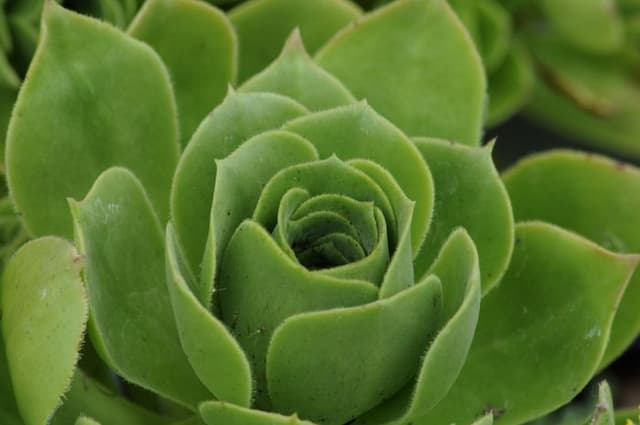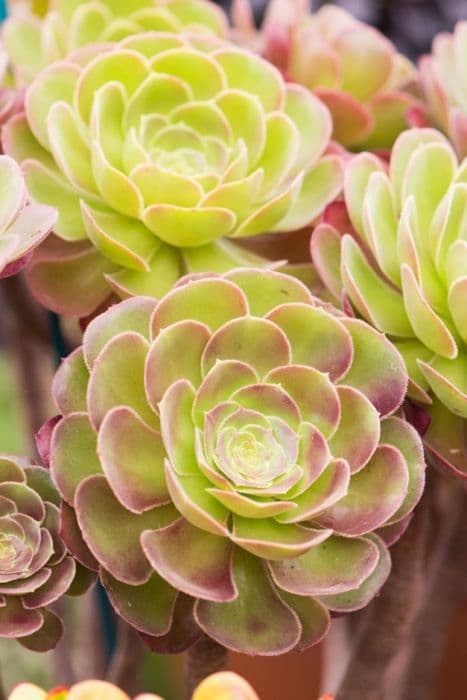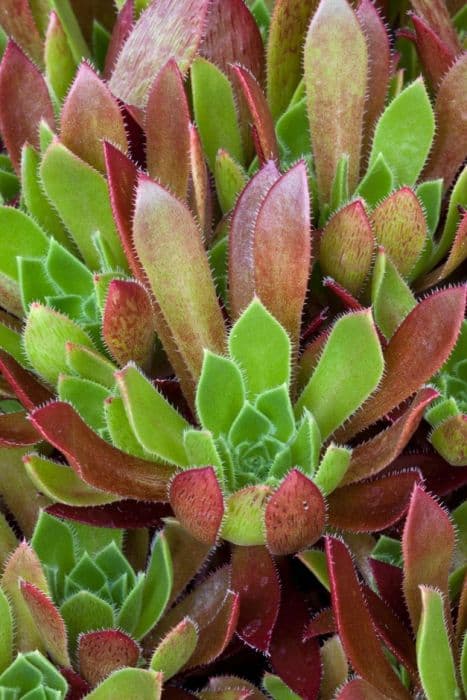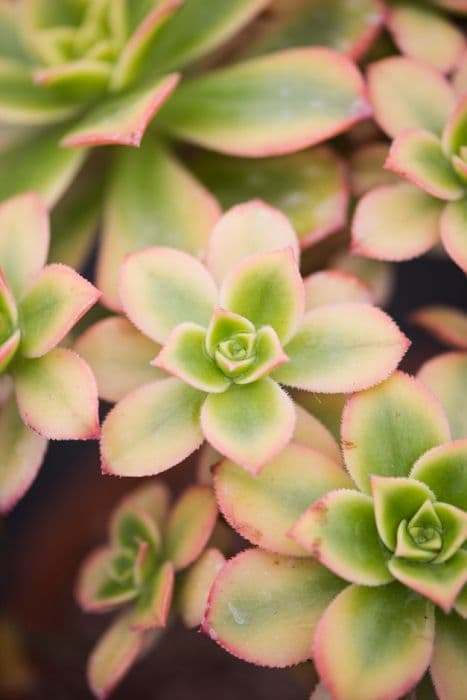Plush Plant Echeveria harmsii

ABOUT
The plant in question, Echeveria harmsii, commonly known as Plush Plant, is characterized by its distinct, succulent features. It sports a rosette formation, consisting of fleshy, spoon-shaped leaves that are soft and have a velvety texture. The leaves display a vibrant green color with reddish-pink edges that add a striking contrast, giving it a decorative appeal. This plant further captivates with its bright orange, bell-shaped flowers that extend from the rosette on tall, arching stalks. The flowers are densely clustered and add an ornamental quality to the succulent. The Plush Plant is recognized for its attractive appearance which makes it a popular choice for succulent collections, rock gardens, and as a decorative houseplant. Its colorful foliage and striking blooms exemplify its ornamental value, making it delightful to plant enthusiasts and gardeners alike.
About this plant
 Names
NamesFamily
Crassulaceae
Synonyms
Plush Plant, Red Echeveria, Brown Echeveria
Common names
Echeveria harmsii.
 Toxicity
ToxicityTo humans
Echeveria harmsii, commonly known as Plush Plant, is generally considered non-toxic to humans. If ingested, it is not likely to cause poisoning or serious harm. However, as with any non-edible plant, ingestion may cause mild gastrointestinal upset in some individuals.
To pets
Plush Plant is also generally considered non-toxic to pets. Ingesting this plant should not cause significant symptoms of poisoning in pets. While it is unlikely to cause harm, ingestion of non-food items can sometimes result in mild gastrointestinal discomfort for pets such as vomiting or diarrhea.
 Characteristics
CharacteristicsLife cycle
Perennials
Foliage type
Evergreen
Color of leaves
Mixed
Flower color
Orange
Height
1 foot (30 centimeters)
Spread
2 feet (60 centimeters)
Plant type
Succulent
Hardiness zones
9
Native area
Mexico
Benefits
 General Benefits
General Benefits- Easy Care: Echeveria harmsii is a low-maintenance plant that can survive with minimal attention, making it ideal for busy individuals or those new to gardening.
- Drought Tolerant: The plant is highly drought-resistant, requiring infrequent watering and thriving in dry conditions.
- Aesthetic Appeal: With its attractive rosette shape and plush, fuzzy leaves, it adds a unique texture and visual interest to gardens or indoor plant collections.
- Suitable for Containers: It is well-suited for container gardening, allowing for easy movement and arrangement in various indoor and outdoor settings.
- Propagation: Echeveria harmsii can easily be propagated from leaves or offsets, making it simple to multiply your collection or share with others.
- Long-lasting: As a perennial, this plant can provide beauty for several years with proper care.
- Seasonal Interest: It may produce bright flowers in the appropriate seasons, offering a burst of color and life to its surroundings.
 Medical Properties
Medical PropertiesThis plant is not used for medical purposes.
 Air-purifying Qualities
Air-purifying QualitiesThis plant is not specifically known for air purifying qualities.
 Other Uses
Other Uses- Echeveria harmsii, also known as "Plush Plant," can be used as an ornamental hair accessory in the form of a live hair clip or barrette for garden-themed events.
- The Plush Plant may serve as a natural art supply; its fleshy, colorful leaves can be used in crafting botanical prints or leaf stamping for creative projects.
- This plant can be incorporated into miniature gardens or fairy gardens due to its small stature and rosette form, adding a touch of realism and whimsy.
- Echeveria harmsii can be implemented in educational settings to teach children and students about plant growth, propagation, and succulent care.
- This succulent can be employed in green roofing projects, especially in arid climates, due to its drought tolerance, helping to insulate and beautify roof spaces.
- As part of a living wall or vertical garden installation, Echeveria harmsii can contribute to aesthetic designs and geometric plant patterns.
- The Plush Plant is used in feng shui practices to introduce elements of nature into the home, believed by some to create a balance of chi or energy.
- The leaves of Echeveria harmsii can be used to create unique plant-based jewelry, such as pendants or brooches, often encased in resin or as living pieces.
- Plush Plant is suitable for pet-friendly homes as it is non-toxic to cats and dogs, making it a decorative and safe choice for plant lovers with pets.
- The distinctive shapes and colors of Echeveria harmsii rosettes can inspire artists and designers in patterns or motifs for textiles, wallpaper, or graphic design projects.
Interesting Facts
 Feng Shui
Feng ShuiThe Echeveria, also known as plush plant, is not commonly mentioned in traditional Feng Shui practice.
 Zodiac Sign Compitability
Zodiac Sign CompitabilityThe plush plant is not used in astrology practice.
 Plant Symbolism
Plant Symbolism- Resilience: Echeveria harmsii, commonly known as Plush Plant, is a succulent that can survive harsh conditions, representing the ability to thrive despite challenges.
- Enduring Love: The Plush Plant's thick, fleshy leaves that retain water symbolize a love that endures and sustains itself through difficult times.
- Adaptability: As a plant that can adapt to various environments, the Plush Plant signifies flexibility and the capacity to adjust to life's changes.
- Beauty and Simplicity: With its attractive rosettes and velvet-like leaves, the Plush Plant underscores finding beauty in simple forms, suggesting an appreciation for the understated elegance of nature.
- Prosperity: In some cultures, succulents like the Plush Plant are believed to bring prosperity and wealth, representing growth and abundance.
 Water
WaterFor the Plush Plant or Echeveria harmsii, it's best to follow a 'soak and dry' method, watering thoroughly only once the soil has completely dried out. Typically, this means watering about every two weeks, but this can vary depending on the humidity and temperature of your environment. When watering, ensure to pour slowly at the base of the plant until excess water drains out of the bottom—this might be approximately 8-16 oz for a small to medium-sized pot every two weeks. During winter, reduce the frequency as the plant enters a dormant phase and the soil stays moist longer.
 Light
LightThe Plush Plant thrives best in bright, indirect sunlight. A spot near a south or east-facing window where it can receive a few hours of morning sun followed by bright, indirect light for the rest of the day is ideal. Avoid harsh direct sunlight during peak afternoon hours, which can scorch the leaves. However, ensure it gets enough light, as insufficient light can lead to etiolation, where the plant stretches out abnormally.
 Temperature
TemperatureThe Plush Plant does well within a temperature range of 65°F to 80°F, which is comfortable room temperature for most homes. It is not frost-hardy and should be kept away from temperatures below 50°F, as prolonged exposure can be detrimental to the plant. Optimal growth will occur when temperatures are steady and do not fluctuate dramatically between day and night.
 Pruning
PruningPruning the Plush Plant is primarily for aesthetic purposes and to remove any dead or damaged leaves, which can promote better growth and prevent disease. The best time to prune is in the spring, just as the plant is entering its active growing season. Prune sparingly and selectively—typically, once a year is enough to keep the Plush Plant looking its best.
 Cleaning
CleaningAs needed
 Soil
SoilThe best soil mix for Plush Plant (Echeveria harmsii) is a well-draining succulent or cactus mix, amended with perlite or pumice to increase aeration and drainage. A typical mix is composed of three parts potting soil, two parts coarse sand, and one part perlite. The ideal pH range for Plush Plant is between 6.0 and 6.5.
 Repotting
RepottingPlush Plant (Echeveria harmsii) should be repotted every two to three years or when it has outgrown its current container. It's best to repot during the plant's active growing season, which is typically in the spring or early summer.
 Humidity & Misting
Humidity & MistingPlush Plant (Echeveria harmsii) prefers low to moderate humidity levels, as it is adapted to arid conditions. It thrives best in an environment where the humidity is below 40%.
 Suitable locations
Suitable locationsIndoor
Provide bright light, avoid overwatering, and place in well-draining soil.
Outdoor
Full to partial sun, protect from frost, ensure good drainage.
Hardiness zone
9b-11b USDA
 Life cycle
Life cycleEcheveria harmsii, commonly known as Plush Plant, begins its life cycle when its seeds germinate in well-draining soil with adequate warmth and indirect light. Seedlings develop into rosettes, showcasing fleshy, spoon-shaped leaves with a soft, velvety appearance. The Plush Plant experiences a vegetative growth stage, where the rosette enlarges, and offsets, or "pups," may emerge at the base, propagating through cloning. As a perennial, this stage can last several years with proper care, characterized by periods of active growth in spring and summer followed by dormancy in winter. During its reproductive stage, usually in spring or early summer, the Plush Plant produces flower stalks with bright orange-red, bell-shaped flowers that attract pollinators. After pollination and seed set, the cycle continues with seed dispersal, and the parent plant typically remains healthy, capable of flowering annually.
 Propogation
PropogationPropogation time
Spring to Summer
Echeveria harmsii, commonly known as Plush Plant, can be propagated most effectively through leaf cuttings. The best time to propagate is during the spring or early summer when the plant is actively growing. To propagate by leaf cuttings, gently twist a leaf from the stem, ensuring that the entire leaf is removed without leaving any part on the stem. The leaf should then be placed on well-draining soil and left undisturbed to allow the wound to callous over for a few days. Afterwards, the leaf will start to produce roots and eventually a new shoot. During this period, it's vital to provide bright, indirect sunlight and moderate watering, being cautious not to overwater to prevent rot. This method is favored for its simplicity and the potential to multiply a single plant effectively.









